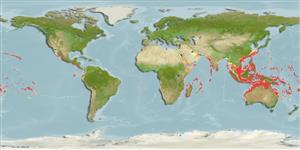Environment / Climate / Range
Ecology
Marine; reef-associated; depth range 1 - 280 m (Ref. 50734), usually 1 - 50 m (Ref. 9806). Tropical, preferred ?; 30°N - 32°S
Indo-Pacific: Persian Gulf (Ref.80050), Red Sea and East Africa (Ref. 3141) to the Hawaiian and Tuamoto islands, north to Ryukyu Islands, south to Lord Howe Island. The Red Sea population differs slightly in coloration and has been known as Ostracion argus; closely related to Ostracion immaculatus from southern Japan. Southeast Atlantic: south coast of South Africa (Ref. 3141).
Size / Weight / Age
Maturity: Lm ? range ? - ? cm
Max length : 45.0 cm TL male/unsexed; (Ref. 9806)
Dorsal
spines
(total): 0;
Dorsal
soft rays
(total): 8-9;
Anal
spines: 0;
Anal
soft rays: 9. Caudal fin rays 10. Juveniles bright yellow with black spots; the spots decrease proportionately and the bright yellow becomes a dirty mustard with growth; large adults become bluish with yellowish seams between the plates.
Inhabit lagoon and semi-sheltered seaward reefs. Juveniles often among Acropora corals (Ref. 9710). Benthopelagic (Ref. 58302). Solitary (Ref. 5503). Juveniles expatriating to subtropical zone from the pelagic larval stage. Small juveniles secretive in narrow crevices (Ref. 48637). Feed primarily on algae with a compliment of microorganisms, invertebrates, mollusks, sponges (Ref. 5503), sand dwelling polychaetes, crustaceans, foraminiferans, and fishes (Ref. 37816).
Life cycle and mating behavior
Maturity | Reproduction | Spawning | Eggs | Fecundity | Larvae
Occurs in harems consisting of single males and 2-4 females (Ref. 37175).
Myers, R.F., 1991. Micronesian reef fishes. Second Ed. Coral Graphics, Barrigada, Guam. 298 p. (Ref. 1602)
IUCN Red List Status (Ref. 115185)
CITES (Ref. 94142)
Not Evaluated
Threat to humans
Harmless
Human uses
Fisheries: minor commercial; aquarium: commercial
More information
ReferencesAquacultureAquaculture profileStrainsGeneticsAllele frequenciesHeritabilityDiseasesProcessingMass conversion
Tools
Special reports
Download XML
Internet sources
Estimates of some properties based on models
Phylogenetic diversity index (Ref.
82805): PD
50 = 0.5039 [Uniqueness, from 0.5 = low to 2.0 = high].
Bayesian length-weight: a=0.05248 (0.03194 - 0.08622), b=2.76 (2.61 - 2.91), in cm Total Length, based on LWR estimates for this species & (Sub)family-body (Ref.
93245).
Trophic Level (Ref.
69278): 3.4 ±0.48 se; Based on food items.
Resilience (Ref.
69278): High, minimum population doubling time less than 15 months (Fec assumed to be > 10,000).
Vulnerability (Ref.
59153): Low vulnerability (23 of 100) .
